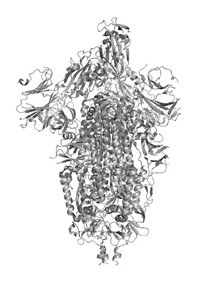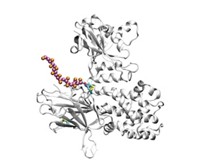Advertisement
Grab your lab coat. Let's get started
Welcome!
Welcome!
Create an account below to get 6 C&EN articles per month, receive newsletters and more - all free.
It seems this is your first time logging in online. Please enter the following information to continue.
As an ACS member you automatically get access to this site. All we need is few more details to create your reading experience.
Not you? Sign in with a different account.
Not you? Sign in with a different account.
ERROR 1
ERROR 1
ERROR 2
ERROR 2
ERROR 2
ERROR 2
ERROR 2
Password and Confirm password must match.
If you have an ACS member number, please enter it here so we can link this account to your membership. (optional)
ERROR 2
ACS values your privacy. By submitting your information, you are gaining access to C&EN and subscribing to our weekly newsletter. We use the information you provide to make your reading experience better, and we will never sell your data to third party members.
Analytical Chemistry
Analyzing Vaccines
Complicated mixtures that make up therapeutics vaccines provide diverse analytical challenges
by Celia Henry Arnaud
April 3, 2006
| A version of this story appeared in
Volume 84, Issue 14
COVER STORY
Analyzing Vaccines
From Pittcon
Today, people around the world face the threat of infectious diseases such as AIDS and avian flu. Because preventing these diseases is far preferable to treating an epidemic, the development of vaccines is desirable. Historically, vaccines have been complex mixtures that were difficult to characterize and often not well-defined. Now, scientists have tools to better define such complicated mixtures. Moreover, subunit vaccines consisting of only a few components that are easier to characterize are becoming more popular. In a symposium at Pittcon, researchers discussed efforts to develop vaccines for a number of diseases, including, in many cases, the associated analytical challenges.
One of the most recent threats is the H5N1 strain of avian influenza virus that has emerged in Asia and made its way to Europe and Africa. Richard Webby, a virologist at St. Jude Children's Research Hospital in Memphis, described the search for new vaccines against H5N1.

Vaccines against flu viruses generally exploit the fact that the virus's genome is organized into eight separate pieces of RNA. Traditionally, new vaccine strains are generated by randomly reshuffling the pieces of RNA from a laboratory strain and the target strain until a hybrid vaccine strain is achieved that contains six pieces of RNA from the lab strain and two pieces from the target strain.
Vaccine researchers no longer need to rely on random reshuffling, Webby said. Using reverse genetics and a plasmid replication system, they can dictate the pieces of RNA in the vaccine strain. (Plasmids are circular pieces of DNA usually found in bacteria.) Reverse genetics is much faster than relying on random reshuffling, Webby said, but the process still takes months to find a virus strain that is a good vaccine candidate.
Vaccines are typically grown in chicken eggs. But the highly pathogenic virus H5N1 is difficult to produce this way because it kills the embryos in the chicken eggs, Webby pointed out. He added that there's still plenty to learn about the pathogenicity of flu viruses such as H5N1, but a major cause appears to be a stretch of basic amino acids in hemagglutinin, one of two surface proteins that characterize flu viruses. For a flu virus to be infective, hemagglutinin must be cleaved by a protease at that particular site. Usually, the proteases needed for such cleavage are found only in the respiratory tract. When additional basic amino acids are inserted at the site, the hemagglutinin becomes susceptible to other proteases, thereby increasing the virus's pathogenicity.
By removing a string of these basic amino acids from the virus, Webby and his coworkers generated an "attenuated" virus that is less pathogenic. In a ferret model of flu, the immune response generated by a vaccine derived from the attenuated virus was such that none of the animals even demonstrated clinical signs of infection. This vaccine is now in clinical trials.
A more widespread virus is the human papilloma virus (HPV), which can cause cervical cancer. More than 24 million women in the U.S. and 600 million women worldwide are infected with the virus. Robert D. Sitrin, the executive director of bioprocess and bioanalytical research at Merck Research Laboratories in West Point, Pa., described some of the analytical development that has gone into Gardasil, Merck's candidate vaccine for HPV. A New Drug Application has been filed with the Food & Drug Administration and is being fast-tracked, Sitrin said.
The vaccine consists of recombinant "viruslike particles" (VLPs) made with a surface protein from the virus. This so-called L1 protein forms a pentamer called a capsomere that self-assembles into the VLP. The entire structure has a molecular weight of about 20 million daltons.
The analytical challenge was in ensuring that each lot of vaccine is comparable with the lot used in clinical trials, and the analytical tests fall into the broad categories of characterization and comparability assays. The characterization tests are used to initially define the product. Once those tests are done, they don't need to be repeated. Comparability tests are simpler assays used to check each lot. For example, once a vaccine's sequence has been determined by mass spectrometry, its rough molecular weight in subsequent lots is checked by polyacrylamide gel electrophoresis.
The key comparability test, Sitrin said, is for potency. The challenge is demonstrating that an analytical method gives the same result as animal studies. Sitrin described a method that Merck uses called in vitro relative potency, or IVRP. In this method, an antibody is used to map the binding sites on the VLP. Once the binding sites have been identified, they can be tested by using a simple immunoassay. The IVRP test indicates whether the VLP is properly assembled. Improperly assembled VLPs evoke a lower immune response. This method is more precise than other tests for potency and does not require killing animals, Sirtin said.
On another front, Vincent Turula, associate director of analytical development at Wyeth Research in Durham, N.C., spoke about the process that Wyeth goes through to update its analytical methods for conjugate vaccines.
Some vaccines contain more than just proteins. Conjugate vaccines are combinations of molecules, typically proteins bound to polysaccharides. Vaccine assembly starts with native viral polysaccharides, which vary in size and chemical composition. The polysaccharides are then activated to generate locations for attachment of "cross-reactive material," which is the part of the conjugate vaccine that generates the immune response.
Wyeth regularly evaluates its analytical tests to see which ones should be improved or replaced, Turula said. The more variable an assay, the higher the priority to improve it. One such test is the spectrophotometric anthrone assay used to quantitate polysaccharides. In this assay, an anthrone reagent reacts with the component monosaccharides in the open form. The assay involves multiple steps, but Wyeth has shortened the assay time and reduced analyst bias with an automated liquid-handling system.
Sometimes completely new methods are needed, Turula said. For example, Wyeth has evaluated the use of capillary electrophoresis with laser-induced fluorescence detection for polysaccharide quantitation, he explained. Other newer techniques include multiple-angle laser light scattering (MALLS) to determine the vaccine's molecular weight and micellar electrokinetic chromatography to quantitate residual free protein. "Classical tests are important and useful," Turula said, "but they should be updated and improved."

Another user of MALLS is Diana Tierra, a chemist in analytical development at Chiron in Emeryville, Calif. She described her group's work to develop techniques for analyzing the HIV envelope protein gp140. This trimer on the surface of the virus particle is being used as an antigen in HIV vaccines. A key required analysis is determining gp140's higher order structure. Higher order structure matters because FDA requires companies to completely characterize all structural levels of biological components, including quaternary structure, which indicates the degree of association among monomer units. By measuring the molecular weight, through size exclusion chromatography with MALLS as a detector (SEC-MALLS), they can tell whether the protein is forming dimers, trimers, or higher order associations.
Not all vaccines are for viruses. Bradford S. Powell, a researcher at the Army Medical Research Institute of Infectious Diseases in Frederick, Md., is helping to develop vaccines against plague and anthrax, both of which are caused by bacteria. Current vaccines for these "diseases of antiquity" are not particularly advanced from the first vaccines introduced decades ago, Powell said. The current vaccine for anthrax causes physical reactions, and a person requires six doses to acquire immunity. The U.S.-licensed plague vaccine is more problematic and no longer manufactured, Powell said.
The new vaccines for plague and anthrax that Powell is helping to analyze will consist of purified bacterial subunits: the rPA protein for anthrax and the rF1-V fusion protein for plague. Both of these vaccines present analytical challenges related to quality control because of their structural heterogeneity.
In the case of the anthrax vaccine, the rPA antigen exists in several isoforms likely caused by deamidation. In this type of spontaneous chemical degradation, asparagine or glutamine residues hydrolytically lose their amide group, but specific demonstration of such changes has been difficult. A common but indirect test for deamidation is a commercial assay that measures the presence of one end product, isoaspartate, but this test is not definitive for deamidation and does not indicate the number or locations of the modified amino acids. Liquid chromatography coupled with electrospray tandem mass spectrometry turned out to be the best method for pinpointing deamidation, Powell said. But even this method requires manual checks of automated assignments for site-specific deamidation, he added.
Powell reported that the usual model for forecasting deamidation is imprecise for rPA. He found seven sites of deamidation, only three of which were predicted by the model and another of which was predicted to have a deamidation half-life of 2 million days. If people rely on the model to guide where they should monitor a protein for deamidation for quality control, they may not choose an actively modified site, Powell said. "The take-home message is that it's not yet easy to measure deamidation in proteins, and predictive models, though good, are still incomplete," he told C&EN.
On the other hand, the challenge for the plague rF1-V antigen, a fusion of two proteins, is that it aggregates, thereby complicating complete characterization of the biological product. Powell characterized all levels of structure, from primary to quaternary, to identify the culprit and also to establish whether aggregation was a consequence of unnatural fusion between the two subcomponent antigens.
After eliminating primary, secondary, and tertiary structure perturbations as possible causes of aggregation, Powell turned to SEC-MALLS to determine quaternary structure. Under physiological conditions, the fusion protein appeared to be a tetramer, whereas the F1 subcomponent appeared to aggregate as a 100-mer. Therefore, aggregation is caused by the F1 subunit of the fusion protein, but the fusion protein architecture reduces this tendency, according to Powell.
MORE ON THIS STORY
- Better Than Ever At Pittcon 2006
- Pittcon, Other Trade Shows May Be Declining In Importance For Small Firms
- Shimadzu Exhibits 50-Year-Old Gas Chromatograph At Pittcon
- Analyzing Vaccines
- Bioimaging With Mass Spectrometry
- Private Eye In The Lab
- Multitasking Cells
- Building Bridges
- Chinese Instrument Market Warms Up
- New & Notable At Pittcon 2006
Vaccines are important weapons against infectious diseases. The development of new analytical tools to characterize these complex products will help bring new vaccines to fruition.




Join the conversation
Contact the reporter
Submit a Letter to the Editor for publication
Engage with us on Twitter